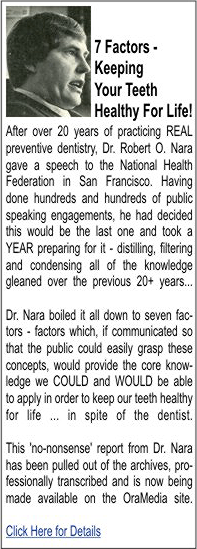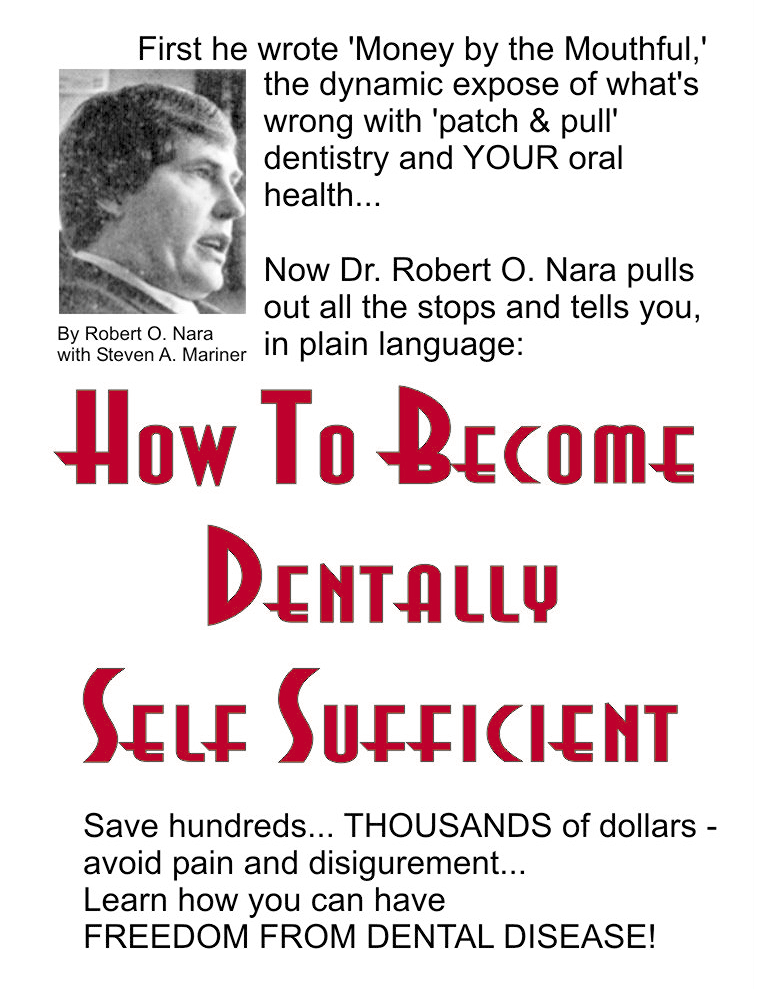| Do
I Really Need A Root Canal? - Dr. Robert O. Nara |
|
 Dr. Robert O. Nara
practiced
preventive dentistry in Houghton Michigan until 1983 - over twenty
years. In his efforts to make people 'dentally self
sufficient'
he came under heavy attack from his peers and wound up temporarily
losing his license to practice for his refusal to 'buckle under'
and talk the party line. Dr. Nara's patients - if
they
wanted to remain his patients - actually became 'dentally
self
sufficient.' They beat gum disease and learned proper oral
care
by changing the way they looked at oral care - then they applied what
they learned and beat the disease themselves.
"How come MY dentist
didn't tell me
about this...Read a fascinating account of how one man went up against the profession - and YOU came out the winner!  "...or this..."  "Since I began using your website, purchased materials and supplies, etc. my periodontal disease has been defeated, according to my dentist (I know the difference too). He has taken note, as has my periodontist, that my case is very unique and inspiring. Significantly reduced pocketing, healthy gingiva, loose teeth tightened up..." -Pastor
G.L.,
New Hampshire
Subscribe to the OraMedia Newsletter for Dental Self Sufficiency |
A root
canal?
--Sounds painful - for sure, expensive... What's it really
all
about?
Several thousand people have asked about the need (?) for this type of dental treatment. It's an honest question, so let's see what an honest answer looks like. First, please, a little background: Teeth are "tough" on the outside, but inside they have a soft core called a nerve chamber. This inner core is made up of nerve tissue and blood vessels that feed the nerve. Serious irritation of the nerve can be caused by deep decay; or perhaps having a deep filling as a result of that decay, or an injury to the tooth. If a nerve degenerates completely the tissues die and gangrene develops. The nerve chamber may also become infected in some cases. This condition, a devital (de-vitalize, 'dead' ) nerve, usually leads eventually to infection with its resulting pain and swelling. We must be very careful to point out here, however, that just because pain and swelling occur does not necessarily mean a root canal is required. Literally millions of root canals have been done when in reality there was no need for this procedure. This is because the dental profession frequently misconstrues gum tissue abscesses as being nerve abscesses. Gum tissue infection can be healed and the problem might be resolved without having a root canal. The biggest problem here stems from the dental profession's over-zealousness in prescribing root canals. There is obviously some economic pressure behind this zeal: Dentists' motive in prescribing the root canal is certainly at least in part because they are expensive. On the other hand, a gum abscess can generally be cleared up either by cleaning out the space where the infection exists --which the patient, in most cases, can do for himself if told how --or, in more serious cases, by judicious use of an antibiotic. Either way it is far less expensive, more simple and probably better for natural long-run health than the root canal alternative. How do you differentiate between a gum abscess and a nerve abscess? Well, it simply isn't always so easy to do, but: If in doubt, try the easier self-help method first. This method uses an irrigating device (cannulae tip adapter), available from OraMedia, to flush out the infection. The device fits on the Via-jet oral irrigator unit. To know if you are getting good results, watch the symptoms. If the pain and swelling begin to go away, quite likely you are hitting at the root of the problem. If symptoms persist, it may be that professional care is necessary. Either way, your mouth will undoubtedly benefit from the added cleaning. (Be sure to do a lot of rinsing with warm, almost hot, salt water solution.) Before you submit yourself for a root canal, make sure that you really need it... You can tell a lot about this yourself. For example, if a tooth has recently darkened in color in comparison to adjacent teeth, this is usually an indication that nerve damage has occurred. If the tooth is sensitive to heat but relieved by cold -- if hotter liquid, for example, makes it hurt and colder liquid seems to ease or eliminate the pain -- this generally points to nerve damage, but not always. Similarly, if the tooth is sensitive to pressure (as in pushing it toward the jawbone with a fingertip), this is another indicator of possible nerve damage... but again, it's not conclusive. Following a period of extra-careful cleaning with a soft toothbrush, lots of salt water, and, if at all possible, use of the special cannula tip and your irrigator -- if the symptoms persist and both above tests indicate "trouble" you may need to see a dentist. Before anything is done... insist on a thorough diagnosis of the situation. If a dentist has been consulted to help determine the need for a root canal, be sure the following steps are taken: 1. Careful visual exam of the teeth (looking for color change). 2. Checking for temperature sensitivity (hot/cold). Note: A more thorough discussion of this whole matter can be found in the book How To Become Dentally Self-Sufficient. 3. Observing any additional sensitivity to pressure; either from biting, tapping or pushing on the suspect tooth. 4. Carefully X-Raying the area(s) in question. Don't allow the dentist to prescribe a root canal only from X-Ray diagnosis, because they are often non conclusive in this regard. Many teeth that "showed need," on X-Ray, for root canal treatment, subsequently healed without it. 5. The tooth should be checked with an electronic nerve tester: A simple device that measures the nerve's ability to react to a mild electrical stimulus. If your dentist has not checked the nerve in this way... and is recommending a root canal... it would be best for you to discuss this with the dentist. If he does not readily offer to do the test - do not, under any circumstances, permit the start of root canal treatment ... ...because, once treatment begins, you are totally commited: You cannot change your mind and 'back out' halfway through the treatment. If all five methods of checking all heavily indicate the need for a root canal you can be about 99% sure it's necessary. If any one or two of the indicators are not conclusive it's generally best to wait for a while. In many cases the situation will "settle down'' and resolve itself. Listen to Dr. Nara discussion on Root Canals (approximately 30 minutes,) Read on... Gum Disease Conspiracy More articles on oral health. This information is presented by the OraMedia web site for dental self sufficiency. More information on preventive dentistry and proper oral health care can be found by clicking here. Let your teeth & gums heal themselves. Dr. Nara's books, "Money by the Mouthful - what you should know about the health of your mouth and body... that no doctor is going to tell you!" and "How to Become Dentally Self Sufficient" are also available from the OraMedia site. Both books are available via email as a package and should be read together to get a good understanding of how to save 'dental dollars' as well as how to save your teeth and gums from 'inevitable' decay and loss. The OraMedia site also offers hard-to-locate products for use in your new oral health program from home. It is suggested, however, that the reader study the material from Dr. Nara's books and the material published at the OraMedia site (and perhaps other preventive dentistry sites) to get a better understanding of the purpose and use of these products in order to make an intelligent, more informed purchase. OraMedia
Home | Articles
on Gum Disease
| Newsletter
Archive
| Dr.
Robert O. Nara
Interview: Freedom From
Dental Disease
| Healthy
Teeth and Gums
| 3
Steps to Acheiving
Proper Oral Health
| Let your
Teeth Heal
Themselves
| How to
Eliminate the Dentist From
Your Life
| Healthy
Teeth in
Children
| FAQ -
Frequently Asked
Questions
| Q&A
With a Periodontal
Patient
| Make
Your Own
Toothpaste
| What
Are You Brushing
With? (Make your
Own Toothpaste Part 2)
Subscribe to the OraMedia Newsletter OraMedia Products; Oral Irrigators, Floss, Mouth Rinse, OraMD, Maxiumum Teeth Whitening... Bad Breath and Gingivitis | Is Your Dentist Taking Shortcuts? | How to Become Dentally Self Sufficient Feelings! | Principles of the Seven Factors for Keeping Your Teeth Healthy for Life | Venus, Mars and Oral Hygiene | Via Jet Pro | TheraSol | Glide Floss | OraMD | Maximum Teeth Whitening | BANA Test | 10 Tips for Keeping Your Teeth Healthy for Life! | OraMedia Newsletter Advertizing | Take Bad Breath Seriously | Behavioral Effects of Fluorides on Mass Populations | What is the Best Way to Purify My Water? | Liquid Minerals | Sonicare Elite Bonus Pack 7700 |